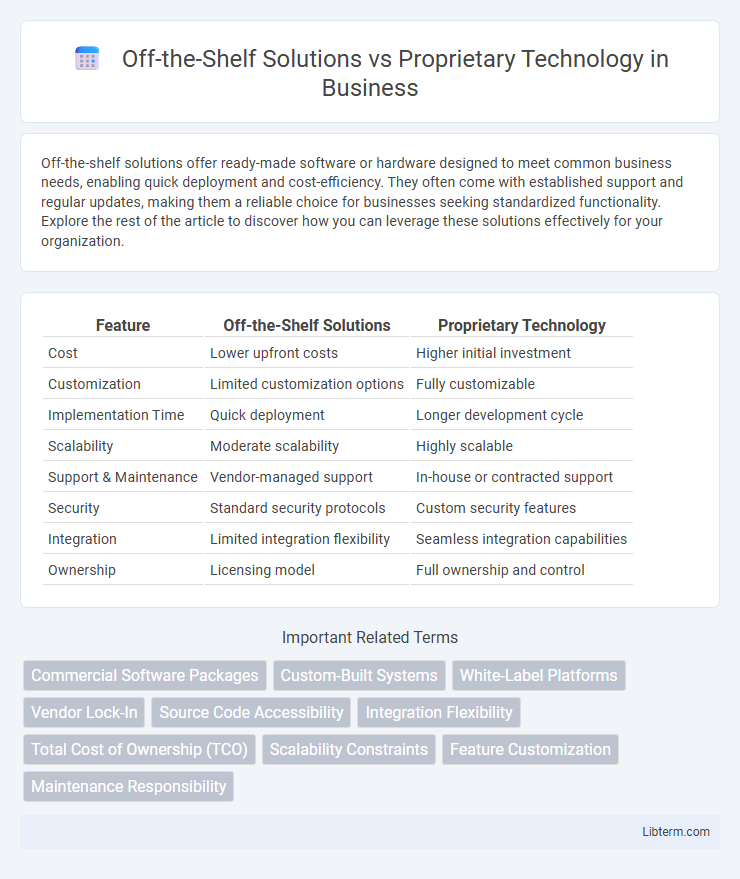Off-the-shelf solutions offer ready-made software or hardware designed to meet common business needs, enabling quick deployment and cost-efficiency. They often come with established support and regular updates, making them a reliable choice for businesses seeking standardized functionality. Explore the rest of the article to discover how you can leverage these solutions effectively for your organization.
Table of Comparison
| Feature | Off-the-Shelf Solutions | Proprietary Technology |
|---|---|---|
| Cost | Lower upfront costs | Higher initial investment |
| Customization | Limited customization options | Fully customizable |
| Implementation Time | Quick deployment | Longer development cycle |
| Scalability | Moderate scalability | Highly scalable |
| Support & Maintenance | Vendor-managed support | In-house or contracted support |
| Security | Standard security protocols | Custom security features |
| Integration | Limited integration flexibility | Seamless integration capabilities |
| Ownership | Licensing model | Full ownership and control |
Introduction to Off-the-Shelf Solutions and Proprietary Technology
Off-the-shelf solutions refer to pre-built software or hardware products designed for general use, offering quick deployment and cost efficiency across various industries. Proprietary technology, in contrast, consists of custom-developed systems owned and controlled by a single organization, tailored to specific business needs and providing competitive advantages. Choosing between off-the-shelf and proprietary solutions depends on factors like customization requirements, budget constraints, and integration complexity.
Core Differences Between Off-the-Shelf and Proprietary Systems
Off-the-shelf solutions offer ready-made software designed for general use, enabling quick deployment and lower upfront costs, whereas proprietary technology involves custom-built systems tailored to specific business needs, providing greater control and unique functionality. Off-the-shelf systems typically have limited customization options and rely on vendor updates, while proprietary systems allow for full customization but require ongoing in-house maintenance and development resources. The core differences lie in flexibility, cost structure, implementation speed, and ownership of technology assets.
Cost Comparison: Upfront and Long-Term Expenses
Off-the-shelf solutions usually have lower upfront costs due to standardized pricing and reduced development time, making them more affordable for immediate implementation. Proprietary technology often involves higher initial investments for customization and development but can lead to lower long-term expenses through tailored efficiency and scalability. Total cost of ownership should consider maintenance, updates, licensing fees, and potential downtime, which vary significantly between both options.
Customization and Flexibility Options
Off-the-shelf solutions offer limited customization options, often requiring businesses to adapt their processes to fit the software's predefined features. Proprietary technology provides greater flexibility by allowing tailored development to meet specific organizational needs and workflows. Custom-built platforms enable seamless integration with existing systems and scalable modifications, essential for dynamic and unique operational requirements.
Scalability: Adapting to Business Growth
Off-the-shelf solutions offer immediate scalability but often lack customization needed for unique business growth trajectories. Proprietary technology can be tailored specifically to evolving operational demands, ensuring seamless expansion and integration with existing systems. While off-the-shelf options provide cost-effective scalability, proprietary solutions deliver long-term adaptability aligned with strategic objectives.
Speed of Deployment and Time-to-Market
Off-the-shelf solutions significantly reduce speed of deployment by providing pre-built features and immediate availability, enabling businesses to launch products faster. Proprietary technology requires longer development cycles due to customization and testing, which delays time-to-market. Companies prioritizing rapid market entry often favor off-the-shelf options for their streamlined implementation and lower lead times.
Security Considerations and Data Protection
Off-the-shelf solutions often undergo rigorous security testing and benefit from regular updates and patches from a broad user base, enhancing their vulnerability mitigation. Proprietary technology offers customized security measures tailored to specific organizational needs, providing greater control over data protection protocols and reducing exposure to common exploits. Evaluating security considerations involves assessing the balance between standardized safeguards in off-the-shelf products and the bespoke defenses in proprietary systems, ensuring compliance with data protection regulations.
Integration with Existing Infrastructure
Off-the-shelf solutions offer faster integration with existing infrastructure due to standardized APIs and broad compatibility but may lack customization to specific business needs. Proprietary technology allows tailored integration aligned with unique workflows and legacy systems, ensuring a seamless fit but often requires longer deployment times and higher costs. Balancing ease of implementation with customization is crucial when choosing between these approaches for optimal operational efficiency.
Vendor Support and Community Resources
Off-the-shelf solutions offer robust vendor support including regular updates, dedicated customer service, and comprehensive documentation, ensuring quick issue resolution and streamlined integration. Proprietary technology may provide tailored vendor support but often lacks the extensive community resources found with widely-used off-the-shelf products. Active user forums, third-party tutorials, and open-source contributions significantly enhance troubleshooting and innovation for off-the-shelf solutions, reducing dependency on vendor assistance.
Choosing the Right Solution for Your Business Needs
Selecting between off-the-shelf solutions and proprietary technology depends on business scalability, customization requirements, and budget constraints. Off-the-shelf products offer rapid deployment and lower upfront costs, ideal for standard operations, while proprietary technology provides tailored features and competitive advantage through unique workflows. Assessing long-term integration, maintenance capabilities, and growth potential ensures alignment with strategic objectives and operational efficiency.
Off-the-Shelf Solutions Infographic

 libterm.com
libterm.com